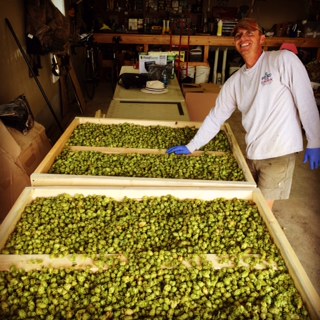 |
| Here's a look at some fresh hops - right from the field! |
This photo was taken from the trailer bed early in the morning. Our approach was to go out and take down the bines for each day's work early, before the heat of the day got up. The quality of hops can suffer pretty quickly if that heat isn't managed - fortunately we had some cooler days, and a light rain on one or two of them, which actually worked in our favor, even if it was somewhat uncomfortable.
 |
| A couple of team members loading the HOP-N-ATOR 4000. |
Once all of the hops were picked off of the bines, we'd take the produce crates and store them in the farm's walk-in cooler until we had all of the variety for that day. I mentioned the haul from day 2 - which was about 32 "wet" pounds from the CTZ/Columbus and the Chinook, but on each of the remaining 3 picking days we had a similar amount from the Cascade rows.
We took two of those rows on Friday, one on Saturday - the day of our harvest event, which I'll write about in the next post - and the final two on Monday. It's not just that we had so many rows of Cascade - these bines are well suited to the US climate and have proven to do well in Virginia, so they were simply bountiful.
 |
| Dried hops, fresh from the HOP-N-ATOR 4000. |
The final photo of the day has David showing off the dried hops after their stint in the HOP-N-ATOR 4000. While our machine did not dry the hops to an optimal 8% moisture, we did manage to get them down to 28% or so. That's enough to stabilize them so they'll retain their potency a few months, and we will handle them by freezing what we don't quickly sell, in order to ensure their quality.
The moisture percentage is a factor we'll work on next year, along with ensuring we can handle the harvest quantities we expect from the maturing bines. As we make progress on those ideas, I'll add some posts - but it will probably be in the winter. Meanwhile, the next post will be about our volunteer harvest event, which we called "Hawksbill Hops Harvest Daze!"
1 comment:
Hello son, I enjoyed your blog about the process and am looking forward to reading the next posts. Great Job!
Post a Comment